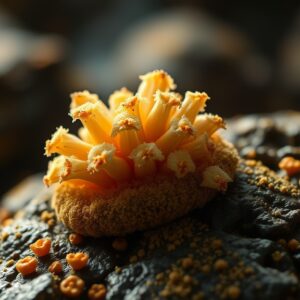Amensalism is a unique ecological interaction characterized by a one-sided relationship where one organism is harmed while the other remains unaffected. This phenomenon plays a significant role in shaping community dynamics, influencing biodiversity, and affecting ecosystem health. Understanding the mechanisms of amensalism is crucial for comprehending how these interactions occur and their implications for ecological balance. This article delves into the various mechanisms through which amensalism operates, providing detailed insights into its biological, chemical, and physical processes.
1. Allelopathy
One of the most well-documented mechanisms of amensalism is allelopathy, a biological phenomenon where one plant species releases chemicals into the environment that inhibit the growth or survival of neighboring plant species. This chemical warfare can significantly affect plant community dynamics and biodiversity.
- Chemical Compounds: Allelopathic plants produce allelochemicals, which can be released through various means, including root exudation, leaf litter decomposition, and volatilization. These compounds can affect seed germination, root growth, and overall plant health.
- Examples:
- Black Walnut (Juglans nigra): The black walnut tree is a classic example of allelopathy. It produces a compound called juglone, which is toxic to many other plants, including tomatoes, potatoes, and certain ornamental species. The presence of black walnut trees can create a zone of inhibition around them, limiting the growth of competing vegetation.
- Sorghum (Sorghum bicolor): Sorghum plants release allelochemicals that can suppress the growth of weeds and other crops. This characteristic is often utilized in agricultural practices to manage weed populations.
- Ecological Impact: Allelopathy can lead to reduced plant diversity in ecosystems, as sensitive species may be outcompeted or eliminated. This can alter community structure and affect the overall functioning of the ecosystem.
2. Competition
Competition is another significant mechanism of amensalism, where one species outcompetes another for limited resources such as light, water, nutrients, or space. This competitive exclusion can have profound effects on community composition and biodiversity.
- Resource Limitation: In environments where resources are scarce, one species may dominate and limit the availability of resources for others. This can lead to the decline or local extinction of the less competitive species.
- Examples:
- Invasive Species: Invasive species often exhibit competitive amensalism by outcompeting native species for resources. For instance, the introduction of the zebra mussel (Dreissena polymorpha) in North America has led to the decline of native mussel populations due to competition for food and habitat.
- Plant Competition: In dense plant communities, taller species may overshadow shorter ones, limiting their access to sunlight. This can lead to reduced growth and reproduction of the overshadowed species.
- Ecological Impact: Competitive amensalism can reduce species diversity and alter community dynamics. It can also lead to shifts in ecosystem functions, such as nutrient cycling and energy flow.
3. Physical Damage
Physical damage is a mechanism of amensalism that occurs when one organism causes harm to another through direct physical interactions. This can happen in various ways, including trampling, grazing, or other forms of mechanical disturbance.
- Examples:
- Grazing Animals: Large herbivores, such as cattle or deer, can trample and damage vegetation while foraging. This physical disturbance can lead to the destruction of plants, particularly smaller or more delicate species, without providing any benefit to the grazers.
- Human Activities: Urbanization, agriculture, and land development can cause physical damage to ecosystems. For instance, construction activities can destroy habitats and lead to the decline of local flora and fauna.
- Ecological Impact: Physical damage can reduce plant cover and biodiversity, leading to changes in habitat structure and the loss of ecosystem services. It can also create opportunities for invasive species to establish themselves in disturbed areas.
4. Pathogen Release
Pathogen release is a mechanism of amensalism where one organism negatively impacts another by acting as a vector for diseases or pathogens. This interaction can have significant consequences for the health of populations and communities.
- Examples:
- Insects as Vectors: Certain insects can carry pathogens that harm plants or other organisms. For instance, aphids can transmit viral diseases to crops, leading to reduced yields and plant health.
- Fungal Pathogens: Some plants may harbor fungal pathogens that can spread to neighboring plants, causing disease and decline. For example, the spread of the fungal pathogen Phytophthora ramorum has led to significant mortality in oak and tanoak trees in California.
- Ecological Impact: Pathogen release can lead to population declines and shifts in community dynamics. It can also affect ecosystem health by reducing biodiversity and altering species interactions.
5. Chemical Inhibition
Chemical inhibition is a broader category that encompasses various ways in which one organism can negatively affect another through the release of toxic substances or metabolic byproducts. This mechanism can occur in both terrestrial and aquatic environments.
- Examples:
- Bacterial Interactions: Certain bacteria can produce inhibitory compounds that affect the growth of competing bacterial species. For instance, some soil bacteria release antibiotics that suppress the growth of pathogenic bacteria, demonstrating a form of amensalism where the beneficial bacteria harm their competitors.
- Aquatic Environments: In aquatic ecosystems, phytoplankton can release toxins that inhibit the growth of competing algal species. This can lead to shifts in community composition and affect nutrient dynamics in the water column.
- Ecological Impact: Chemical inhibition can shape community structure and influence nutrient cycling. It can also have implications for food webs, as changes in species composition can affect the availability of resources for higher trophic levels.
Conclusion
The mechanisms of amensalism are diverse and complex, encompassing allelopathy, competition, physical damage, pathogen release, and chemical inhibition. Each of these mechanisms plays a crucial role in shaping ecological interactions, influencing biodiversity, and affecting ecosystem health. Understanding these mechanisms is essential for ecologists, conservationists, and land managers as they work to preserve biodiversity and maintain the balance of ecosystems. By recognizing the intricacies of amensalism, we can better appreciate the delicate web of life that exists in our natural world and the importance of protecting it for future generations.
